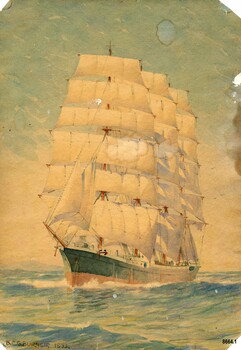Historical information
Beni Carr Glyn Burnett (also known as B. C. G. Burnett or Beni Burnett) was born in 1889 to missionary parents in Mongolia. When he was 15 years old he began training as an architect with a firm in Shanghai. He worked in Singapore, Japan and China before moving to Australia around 1933. In 1937 he was appointed as the Commonwealth principal architect in the Northern Territory. He went on to design a series of houses for senior public servants and military personnel which became very popular as they were specifically designed for the tropics - incorporating louvres, high ceilings and good ventilation. When Darwin was bombed in February 1942, he was evacuated to Alice Springs where he continued to work as an architect. He also became a Magistrate and Coroner in Alice Springs. In later life he was well known for sketching clientele in public bars. He died in 1955.
Beni Burnett was living in Sydney in 1933 when he produced these three artworks.
There were several photography firms operating in Sydney at this time who specialised in photographing ships and the shipping trade (e.g. Samuel J. Hood and William James Hall) and whose photographs were used by artists to produce ship portraits. Both of these photographers took photographs of the two ships in B. C. G. Burnett's watercolours.
The "Magdalene Vinnen" was photographed by Samuel J Hood in a series of photos taken in March 1933. It was a 4 masted steel barque, built in 1921 in Kiel, Germany and for almost 80 years was the largest traditional sailing ship in operation. She was used extensively as a cargo ship. She sailed into Sydney Harbour on 27th Feb 1933, loaded with almost 16,000 bales of wool destined for Falmouth, England. In March 1933 (whilst in Sydney) the German Republic flag (on orders from Adolph Hitler) was lowered and replaced with the old monarchist flag which was then to be the official flag and beside it the Nazi flag was to be flown on all ceremonial occasions. It visited Australia again in 1935 with its cargo being wheat from Port Broughton, S. A. In 1936 it was renamed "Kommodore Johnsen" and in 1945 (after WW2) the ship was awarded to the Soviet Union as war compensation and renamed "STS Sedov".
Significance
This painting (one of a set of 3 small artworks) is significant as an example of shipping (particularly the use of sailing ships) that were still being used as late as the 1930's in Australia. It is also important because its creator (B. C. G. Burnett) went on to become a well-known public figure in the Northern Territory in the late 1930's due to his innovative approach to designing homes for the tropical climate.
Physical description
A watercolour painting of a sailing ship called "Magdalene Vinnen". It shows a 4 masted barque with a blue and red steel hull in full sail heading towards the viewer. The painter's name (B. C. G. Burnett) and date (1933) are written on the bottom left-hand corner of the painting. The location and name of the ship is written in ink on the back of the painting.
Inscriptions & markings
front - "B. C. G. BURNETT. 1933
back - "off Sydney" / "Magdalene Vinnen"
Subjects
- flagstaff hill maritime museum and village,
- warrnambool,
- great ocean road,
- sailing ships,
- ships,
- barque,
- magdalene vinnen,
- beni carr glyn burnett,
- b. c. g. burnett,
- beni burnett,
- painting,
- watercolour painting,
- sketch,
- sydney harbour,
- architect,
- darwin,
- burnett house,
- photography,
- samuel j. hood,
- william james hall,
- sedov,
- kommodore johnsen
References
- Magdalene Vinnen The Australian National Maritime Museum has a collection of photographs (and information) on the ship "Magdalene Vinnen" and the photographer "Samuel J. Hood".
- German Ship Ceremony A report in the Newcastle Morning Herald and Miners' Advocate (NSW:1876 - 1954), Friday 24th March 1933, page 6 which describes the flag ceremony on board the Magdalene Vinnen.







